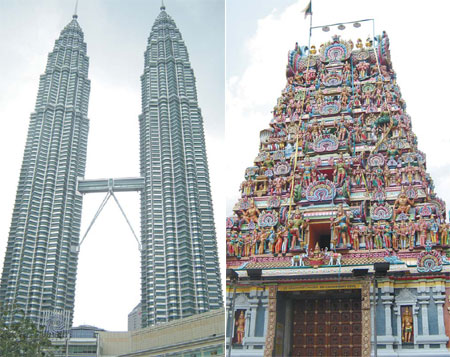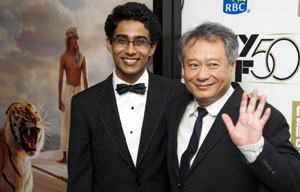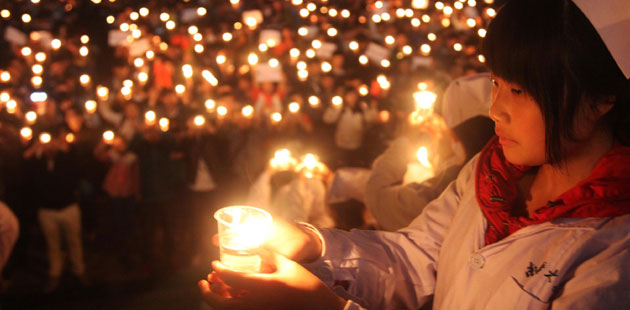Nature, art, durians & roti
Updated: 2013-07-07 08:36
By Felix Pouce (China Daily)
|
||||||||

|
Merdeka Square is one of the most significant landmarks in the city, facing Sultan Abdul Samad Building. Other landmarks are the Petronas Twin Towers (top left) and the Hindu Temple. Photos by Felix Pouce / for China Daily |
Most of us are familiar with the Malaysia, Truly Asia jingle. Felix Pouce visits the multicultural country and discovers some of its more unusual attractions.
When I was a child I read the One Thousand and One Nights. Sindbad the Sailor was one of the stories. Every island he came across has its mysteries, weird animal or oddities. It is said that Malaysia and Indonesia inspired the people who wrote the tale. Immediately after discovering Kuala Lumpur, Sindbad came to mind. Although not far away from China, everything is different. Rimba Ilmu is the University of Malaya Botanical Garden and a delicious way to discover the incredible plants growing in Malaysian rainforest. It's easily reachable with the metro.
Forest Research Institute is a big park and research compound, a bit far away but interesting to visit for nature lovers. Different collections of tropical trees and plants scatter around the park. Wildlife is easily seen, like monitor lizards, huge snakehead fish or leaf monkeys, not to mention columns of ants that seem to reach the sky along the higher tree trunk.
The Central Park is a big area with a huge walk-in aviary and a butterfly farm, where lovely mouse deer whose legs are thinner than a pencil roam the area.
A good place if you are with children.
Kuala Lumpur City Centre and the Petronas Twin Towers house a huge shopping mall. Almost every global luxury brand is there, plus a number of local ones.
I was particularly attracted to beautiful modern Indian shawls and sari.
Little India is more for the tourist on a budget but still offers interesting items. Early in the morning a flea market display discoveries like semi precious stones and cheap batik, products made of shells, mother-of-pearl, among others.
Majority of the population in Malaysia are Muslims and Muslim people have a long tradition and taste for perfumes.
Even in small town markets you always find a cosmetic display with lots of incense.
There is revival in Little India of natural oils such as agarwood, ylang-ylang or benjoin. Small shops and craftsmen can create your own perfume, and they also offer their own creations.
No famous brands or pop star endorsements, but you can pick your bottle of fragrance, highly priced but of genuine quality.
One drop on my skin lasted three days, even after repeated showers - a miracle and a delight.
The Muslim culture allows the women to show little skin. Quite often only the face and hands are visible. Tunics and baggy pants are normal casual wear for modern women.
Also available are all sorts of fabrics in bright colors, and all sorts of cosmetics and small pieces of jewelry.
At dawn, trucks are seen selling durian - a fruit famous for its pungency. To me, it's delicious and one of Kuala Lumpur's greatest snacks.
Indian food and Malaysian dishes are a treat for me, such as laksa - a local way of serving noodle in a broth of coconut milk, chicken, and various spices.
It's delectable but not suitable for those on a diet.
Coffee is in every shop and quite good, flavored with condensed milk, evaporated milk, goat's milk, ginger or other local spices. Along with roti - a fried bread - and eggs, it constitutes an excellent breakfast.
Malaysia culture is virtually unknown in Europe, and there is a lot to discover. Kuala Lumpur has at least three museums that will help.
There is a beautiful museum dedicated to Islamic arts - with samples not only from Malaysia but from all over the Muslim world.
Exhibits cover ceramics from Spain or Morocco, calligraphy and jewelry from India, as well as all sorts of clothes. Models of the most famous mosque in the world are also on display, with panels giving explanations.
The Muzium Negara or National Museum, is dedicated to traditional Malaysian life, including that of the ethnic groups. You will learn about the Sultans and their role in the country, the Arabic influence as well as about Orang Asli, the indigenous people.
There is also a textile museum showing the art of Batik, dyed cloth; Ikat, wowen cloth with dazzling pattern; as well as the Peranakan Chinese exquisite embroidered works.
Kuala Lumpur is a patchwork of architecture - from the very modern but still personal Twin Towers, to more traditional colonial bungalows.
Hindu temples with their multicolored stucco facade representing deities are quite obvious around the cities and can be visited barefoot.
During the fasting month of Ramadan, food stalls pop up at dusk at every corner selling anything from dates to dumplings.
On one of my last days there, I saw a very touching event: Merdeka Square was covered with long rolls of papers serving as placemats.
At dusk, families came with homemade food, and dinner was eaten together.
Hundreds of people, including children and grandmothers, celebrated the end of the fasting period. It was the end of the Ramadan, and also the end of my journey.
Contact the writer at sundayed@chinadaily.com.cn.


 'Despicable' minions upset Depp's 'Lone Ranger' at box office
'Despicable' minions upset Depp's 'Lone Ranger' at box office
 'Taken 2' grabs movie box office crown
'Taken 2' grabs movie box office crown
 Rihanna's 'Diamonds' tops UK pop chart
Rihanna's 'Diamonds' tops UK pop chart
 Fans get look at vintage Rolling Stones
Fans get look at vintage Rolling Stones
 Celebrities attend Power of Women event
Celebrities attend Power of Women event
 Ang Lee breaks 'every rule' to make unlikely new Life of Pi film
Ang Lee breaks 'every rule' to make unlikely new Life of Pi film
 Rihanna almost thrown out of nightclub
Rihanna almost thrown out of nightclub
 'Dark Knight' wins weekend box office
'Dark Knight' wins weekend box office
Most Viewed
Editor's Picks

|

|

|

|

|

|
Today's Top News
Boeing 777 passenger 'mumbled a prayer'
Ex-minister gets suspended death
Workers return after dispute
Job seekers should be cautious abroad
River pollution sparks criticism
Terror attack was planned: suspect
Booming security industry needs skilled youth
A bright future for native black pigs?
US Weekly

|

|








